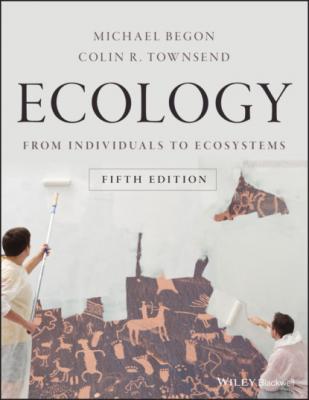Ecology. Michael Begon
Читать онлайн.| Название | Ecology |
|---|---|
| Автор произведения | Michael Begon |
| Жанр | Биология |
| Серия | |
| Издательство | Биология |
| Год выпуска | 0 |
| isbn | 9781119279310 |
Source: (a, b) After Ainsworth & Long (2005). (c) After Bishop et al. (2014).
Such responses are in part simply a reflection of a greater availability of resource (CO2), but there is likely to be an additional effect, especially in C3 plants, resulting from a reduced need for stomatal opening and the consequent reduction in water loss. This reduction in stomatal conductance has indeed been observed, at least in crops and especially under drought conditions (Figure 3.22a). This in turn suggests that such increases in yield at higher CO2 concentrations should themselves be higher when there is reduced availability of water, since this is when the benefits of conserving water will be greatest. This, too, has been confirmed (Figure 3.22b).
Figure 3.22 Stomatal conductance is decreased by enhanced CO2concentrations, leading to increased yields especially when water is scarce. (a) Mean responses from the meta‐analysis in Figure 3.21c of stomatal conductance (gs) to enhanced CO2 concentrations ([CO2]) in free air CO2 enrichment facilities (FACE) experiments with crop plants, classified according to different additional treatments. Bars are 95% CIs. (b) The significant negative relationship of the yield increases in Figure 3.21c to the level of water availability (y = 1.36 – 0.0005x; r2 = 0.24; P = 0.009).
Source: After Bishop et al. (2014).
We should not be tempted by these general patterns, however, into thinking that responses to elevated CO2 concentrations will be straightforward and predictable. The results of a 20‐year FACE experiment, in which the responses of C3 and C4 grasses were compared, are shown in Figure 3.23. For the first 12 years of the experiment, the results were as might conventionally have been predicted. There was a marked increase in biomass in C3 plots compared with those experiencing ambient CO2, but no such response in C4 plots. However, this pattern was reversed in the subsequent eight years (Figure 3.23a). The explanation for this reversal is uncertain, but it is associated with a shifting balance in the effect of CO2 enhancement on the availability of nitrogen in the soils of the contrasting plots. The effect was positive initially in the C3 plots (more nitrogen available) but became increasingly negative, and was negative initially in the C4 plots but became increasingly positive (Figure 3.23b). And overall in the experiment, positive effects of CO2 enhancement on nitrogen availability gave rise to positive effects on biomass. The authors of the study admit, frustratingly, that the underlying basis of these nitrogen cycling responses remains an open question. But these results do at least remind us, first, that short‐term responses may be misleading in predicting the consequences of what are likely to be long‐term trends, and also, that the changing availability of one resource may, within the community as a whole, give rise to altered levels of other resources with equally profound consequences.
Figure 3.23 Effects of elevated CO2concentrations on C3and C4grasses are reversed over the longer term. (a) Changes in biomass over a 20‐year period in a free air CO2 enrichment facilities (FACE) experiment comparing the responses of C3 and C4 grasses to enhanced CO2 concentration (eCO2) relative to ambient levels (ambCO2). Data shown are three‐year moving averages. In an analysis of variance, the interaction between year, treatment and C3/C4 was significant (F = 7.2; P < 0.01): the difference in response between C3 and C4 grasses reversed over time. (b) The effect in the experiment on net nitrogen mineralisation (a measure of nitrogen availability to the plants averaged over successive five‐year periods). Bars are SEs among years. In an analysis of variance, the interaction between year, treatment and C3/C4 was significant (F = 4.0; P < 0.05): the difference in response between C3 and C4 grasses reversed over time.
Source: After Reich et al. (2018).
APPLICATION 3.4 Harmful effects of plants’ responses to CO2 enrichment
Along similar lines, it is well established that there is a general tendency for CO2 enrichment to change the composition of plants, and in particular to reduce nitrogen (and hence protein) concentrations in above‐ground plant tissues (Cotrufo et al., 1998), which may in turn have indirect effects on plant–animal interactions, because insect herbivores may then eat more foliage to maintain their nitrogen intake and fail to gain weight as fast (Fajer, 1989). CO2 enhancement may also reduce concentrations in plants of other essential nutrients and micronutrients (see Section 3.5), contributing in turn to ‘micronutrient malnutrition’, which diminishes the health and economy of more than one‐half of the world’s human population (Loladze, 2002).
Examples of the effects on nitrogen content are shown in Figure 3.24. First, when wheat was grown at enhanced CO2 concentrations, effects depended on whether soils had adequate nitrogen (low‐N) or this was supplemented with further fertilisation (high‐N) (Figure 3.24a). In the low‐N treatment, the protein concentration of individual grains was substantially reduced, but enhanced growth overall meant that the protein harvested from the grain was much less reduced. Indeed, in the high‐N treatment, the effect on concentration was negligible, such that the protein harvested overall from the grain was increased by CO2 enhancement. On the other hand, it was possible to pinpoint
